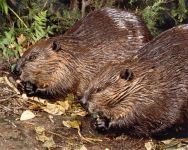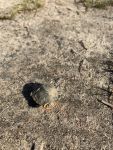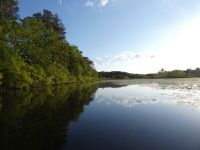Beaver Tales from Unexpected Wildlife Refuge, April 2022
Red-bellied turtle
Main pond in spring
Spring is beginning to bloom at the Refuge! Life is awakening for the spring/summer season and that includes newly hatched red-bellied and eastern painted turtles. They are tiny and sometimes barely visible as they make their way from their nest sites to the ponds, blending in with their surroundings. As these young turtles emerge to make a new life among the waterways, other animals are being born, hatching from protective egg cases, or simply waking up to the new season. Like the wildlife, we have also had a busy start to spring at the Refuge, welcoming new visitors and volunteers, and representing UWR at local events.
manager@unexpectedwildliferefuge.org to schedule.
Running a wildlife refuge is not only physically and emotionally demanding, there are always expenses with which to deal. Although we are frugal in how we spend Refuge funds – having only one employee and an all-volunteer Council of Trustees – we need your help in ensuring the continuation and longevity of the Refuge. We hope you will take the time to make the most generous donation you can...now . Please know that we – and the wildlife – are grateful for your continued support.
Contents of this month's newsletter:
Support wildlife at the Refuge
As part of the vital and globally unique ecosystem that is the Pine Barrens, the Refuge is home to many endangered and threatened species. Please make a pledge to sponsor a Refuge habitat or choose to support one of the species of animals who call this protected land 'home.' You can easily do this through an automatic monthly PayPal donation (you do not need a PayPal account, just a credit card). Go to our Donate page to make your choice and subscribe. Your recurrent donations will be used, as with all our income, to continue protecting the Refuge from harm and allowing the inhabitants to live freely.
Wetland habitat: $30.00
Pine forest habitat: $25.00
Bald eagle: $20.00
Beaver kit: $15.00
Muddy Bog
Bald eagle
Beaver
River otter: $15.00
Eastern box turtle: $15.00
Red fox: $10.00
Your personal favorite: $20.00
All habitats and animals: $60.00
River otter
Eastern box turtle
Red fox
News items
Trustee Dave Sauder
UWR table
UWR at Lines on the Pines, March 13, 2022
ACUA Earth Day Festival
Janet Romano & Jen Collins
UWR at ACUA’s 30th Annual Earth Day Festival, April 24, 2022
Snapshots of life at the Refuge
Otter family
Otter family
Otter family
Otter family active at Wild Goose Blind
Red-bellied turtle
Turtle hatchling reaches destination
Song sparrow
Song sparrow in the brush
Groundhog at HQ
Groundhog at HQ
Groundhog neighbors at Headquarters
Kids' corner section below.
Eastern spadefoot toad
Eastern spadefoot toad
Young eastern spadefoot toad
Rough-winged, tree & barn swallows
Rough-winged and tree swallows
Swallows
Several species of swallows at Miller Pond
Kids' corner
When children have opportunities to observe wildlife, a whole new world of wonder can open up. Let's see what it's like to observe the wildlife at UWR from a kid's perspective.
Groundhog family
Groundhogs by Sylvia Cudrak, age 8
Beavers in the news
Here are some recent news media articles concerning beavers. You can see our entire and growing list, a tribute to this wonderful keystone species, in our Beavers in the News page . If you come across a news item on beavers, please send us the link so that we can consider it for inclusion.
South Charlotte Residents Upset with how Beaver Colony is Being Handled , by Drew Bollea.
Beavers
A group of residents in the Thornhill neighborhood in South Charlotte say the home owners association trapped and killed a family of beavers without seeking humane solutions.
Traditional Farming Communities Coexist with Beavers , by Patricia Estrella.
Beaver
By building dams and lodges, beavers are considered ecosystem engineers.
Campaigns in New Jersey
American black bears
Bear advocacy is critical until bears are permanently protected. Please continue the fight!
Reusable bags
NJ Plastic Bag and Polystyrene Ban Goes Into Effect May 4, 2022 Get Past Plastic .
Contact us
Unexpected Wildlife Refuge
http://unexpectedwildliferefuge.org/
info@unexpectedwildliferefuge.org








